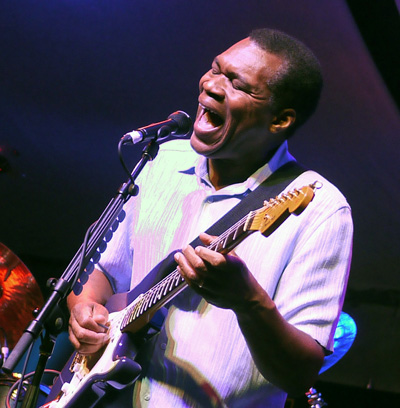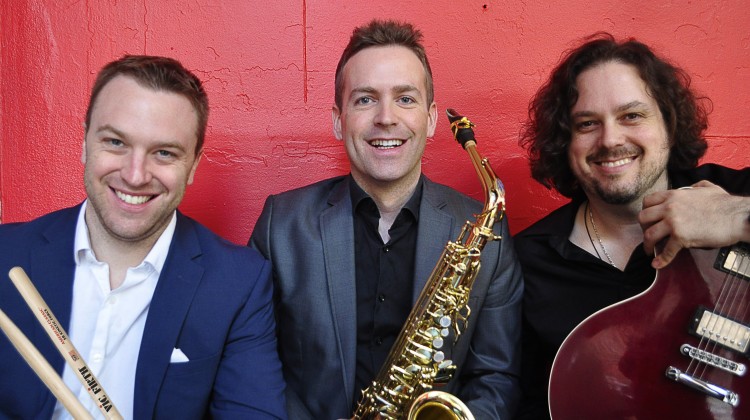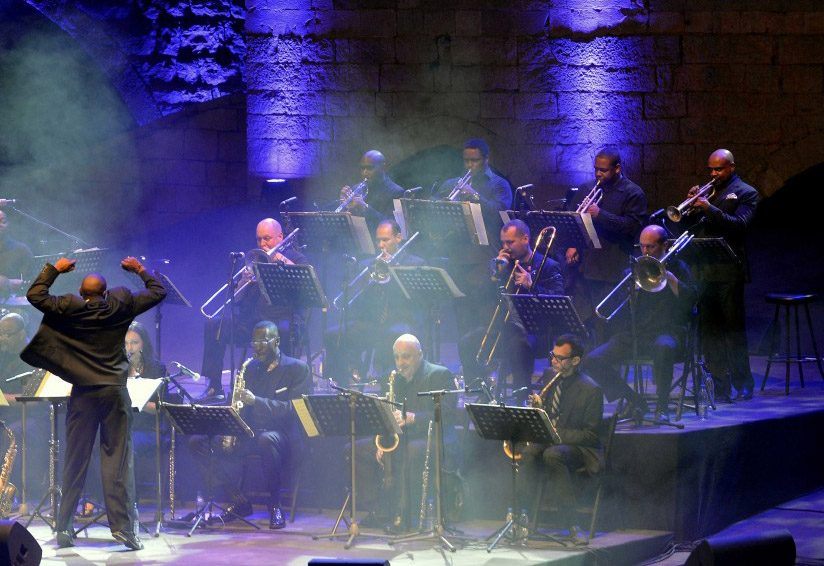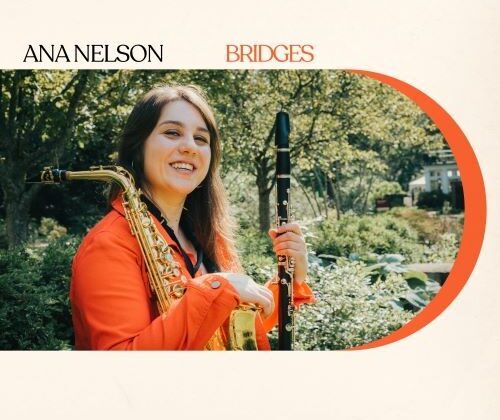Appropriately released during the college football season, the Visions Jazz Ensemble’s Across the Field re-imagines 13 college fight songs traditionally performed by college and university marching bands.
No doubt, many of the members of these marching bands—and members of many many others throughout the country who take to the fields during autumn pregame and halftime shows—are studying advanced music when they aren’t practicing new music and new formations for the big games.
Accordingly, they would appreciate the original interpretations that the ensemble explores.
No doubt, arrangers Sam Butler and Garrett Fasig are familiar with football fans’ “generous” enthusiasm. After all, Butler and Fasig chose the album’s collegiate fight songs for their interpretative potentials after investigating the collegiate traditions of each piece. In addition, they have applied their immersions in the jazz tradition and their understandings of music theory to transform fight songs into music that might be heard in a jazz nightclub.
A review of the biographies of many major jazz musicians reveals that they pay forward by teaching in university jazz studies departments.
Such is the case for trumpeter Butler and saxophonist Fasig too.
Both have received master’s degrees in music from the esteemed Indiana University’s Jacobs School of Music in Bloomington.
Butler has gone on to win the 2023 International Trumpet Guild Jazz Solo Competition and to release his first album, Folklore.
In 2020, a neurological condition interrupted Fasig’s technical development on the saxophone. However, the flexibility of IU’s Jazz Studies Department allowed him to concentrate on composition. Such flexibility may have reflected the experiences of the department’s founder, David Baker, who, after a 1953 automobile accident, switched to cello and developed a curriculum in jazz studies. Eventually, Fasig received the David N. Baker Jazz Composition Scholarship from BMI. In addition, Fasig has arranged for the Brent Wallarab Jazz Ensemble, jazz singer Brianna Thomas, and the New York Youth Symphony.
Baker, a Kennedy Center Living Jazz Legend, founded the country’s first Jazz Studies Department at Indiana University in 1968; he taught there until 2013. In 1991, Baker and Gunther Schuller became the first artistic and musical directors of the Smithsonian Jazz Masterworks Orchestra. Baker’s tenure at IU attracted future professional jazz musicians like Michael and Randy Brecker, Jim Beard, Sara Caswell, Peter Erskine, Jamey Aebersold, Chris Botti, Jeff Hamilton, and John Clayton
Baker also encouraged IU associate professor Brent Wallarab to join the Smithsonian Jazz Masterworks Orchestra as lead trombonist and to transcribe more than 300 jazz masterworks from composers like Duke Ellington, Fletcher Henderson, and Gil Evans. In 2023, the distinguished Buselli-Wallarab Jazz Orchestra released The Gennett Suite. The album documented the importance of Richmond, Indiana-based jazz label, Gennett Records, in recording in the early 1920’s some of the first recordings of Louis Armstrong, Hoagy Carmichael, Bix Beiderbecke, Lawrence Welk, King Oliver, and Jelly Roll Morton.
The historical stream of arts support within Indiana continued when the Indiana Entertainment Foundation suggested that Butler and Fasig arrange fight songs for the Vision Jazz Ensemble.
The idea was a smashing success when they first performed their arrangements at the Silo Club in Indianapolis. In fact, the audience there sang along to “Indiana, Our Indiana,” IU’s alma mater written by former band director Russell Harker early in the nineteenth century.
Across the Field is the fulfillment of that idea.
The members of the Visions Jazz Ensemble re-create on Across the Field that moment at the Silo Club. They too respectfully sing “Indiana, My Indiana’s” first chorus, as do thousands at an IU home game. But arranger Fasig craftily used the chorale to lead, at the final mediant chord, into a brassy instrumental chorus before trumpeter Nick Recktenwald’s swinging improvisation. The track’s modal finish returns to calmness as pianist Dan Ventura develops crystalline treble-clef lines over the horns’ voicings.
So, among the abundance of available fight songs, which ones did Butler and Fasig choose for Across the Field?
Without preference for any conference, but based upon the songs’ jazz potential, Butler and Fasig chose to include, in this order:
“Tiger Rag,” Anchors Aweigh,” “Indiana, Our Indiana,” “Rocky Top,” “Across the Field,” “Glory, Glory,” Hot Time in the Old Town Tonight,” “Fight On,” “Hail Purdue,” “The Victors,” “Ramblin’ Wreck,” “Victory March,” and “On Wisconsin.”
Besides the thoughtful harmonic and rhythmic innovations within the jazz arrangements, the Visions Jazz Ensemble’s interpretations are striking not only for their thoroughly considered adaptations, but also for their varieties of moods.
That is, Butler and Fasig have advanced the songs’ mood, usually fighting to win “the game,” to encompass a broader range of emotions, often based upon the songs’ origins.
How so?
Well, how about Butler’s conversion of Notre Dame’s “Victory March” into a lightly swaying jazz waltz, initially anchored by bassist Jacob Smith’s pedal point and evolving into a palette of harmonic colors? During the first two relatively straightforward choruses, understated by Jeff Parker’s solos during the first minute, the “Victory March” inserts blues chords for a vamp-based 6/8 swing (in the middle of Fasig’s throaty tenor sax solo). Ventura improvises with block chords and tremolos. The track ends with the entire group improvising over the chords.
Not all the songs were initially written as fight songs. Some just ended up that way. “Tiger Rag,”, first recorded by
The Original Dixieland Jass Band in 1917 first recorded “Tiger Rag,” an eminently adaptable composition for more than a century, on the Aeolian-Vocalion label. It ended up in 1926 as Louisiana State University’s pregame song. LSU’s Tiger Marching Band plays it after every LSU touchdown too. But that’s not all. Auburn University’s marching band also plays it, as do Clemson University and the University of Texas at Dallas. Which tradition did Butler choose for his arrangement? LSU’s, of course. Francis Bassett-Dilley’s drum solo starts the excitement. Then, Butler breaks the song into re-harmonized segments, allowing Bassett-Dilley to continue drumming between rests. A whimsical bitonal bridge in a meter of three contrasts with the 4/4 A section. And then, at 1:04, the septet plays a straightforward version, providing an up-tempo platform for Butler’s electrifying solo. After moving into a New Orleans-influenced second-line rhythm, uninhibited group improvisations conclude the piece.
Butler’s arrangement of the Georgia Institute of Technology’s “Ramblin’ Wreck” respects its Scottish origins from Charles Ives’s eighteenth-century song, “Son of a Gambolier.” Butler achieves this acknowledgement with another slow, introspective introduction. That intro is yet another reminder of Butler’s and Fasig’s outstanding use of multi-hued voicings to paint an image with but four horns. At :38, Bassett-Dilley changes the mood by referring to the fight song’s galloping rhythm. Cleverly, Butler sets up a spirited version played by flute and Harmon-muted trumpet, recalling a drum-and-bugle-corps approach. But not for long. Swing ensues. The remainder of the track seems to be inspired by the originality of Benny Golson’s “Blues March,” made famous by Art Blakey’s Jazz Messengers. Recktenwald’s outstanding solo may be a reminder of Lee Morgan’s, and Smith’s pizzicato solo emerges over the shuffle with a melodic statement of his own.
Fasig considers not only the Big Ten, Big 12, and SEC conferences. “Anchors Aweigh,” honoring the AAC’s Naval Academy’s Midshipmen, upends the song’s familiarity by slowing the melody into a Basie-like lightly swinging arrangement of swelling and diminishing dynamics and tightly chorded harmonies. Fasig improvises authoritatively with a musical narrative suggestive of Dexter Gordon’s influence.
Serendipitously, renowned jazz trombonist Wycliffe Gordon happened to be in Indianapolis when the Visions Jazz Ensemble was performing. He offered some of his seasoned perspectives about arranging. Accordingly, Butler and Fasig chose “Hot Time in the Old Town Tonight” to pay tribute to Gordon’s alma mater, Florida A&M University. Consisting of several sections—as do most of their other arrangements on Across the Field—“Hot Time in the Old Town Tonight” begins as a dirge-like New Orleans street march. Gordon comes in at the second medium-tempo chorus, and the listeners of the album are treated to Gordon’s inimitable, exhilarating, human voice-like improvisations. At the key change, Butler comes in with a bright and forceful solo, like the enthusiasm of his solo on “Tiger Rag.” Then, Gordon returns to lead a thrilling concluding fanfare involving the entire group. Wittily, the phrase before the final chord quotes “I’m gonna wash that man right out of my hair” from South Pacific.
How did Butler and Fasig—with their understandings of music theory, the jazz tradition, and collegiate rivalries—imaginatively arrange the other fight songs on Across the Field?
Each song has a different history. Each college or university has a separate tradition. Each arrangement developed organically from each song’s origins. Each arrangement is unique.
You’ll have to hear for yourself how the Visions Jazz Ensemble performs your favorite collegiate fight song.
Artist’s Web Site: www.visionsjazzensemble.com
Label’s Site: https://www.indianafound.org/shop









